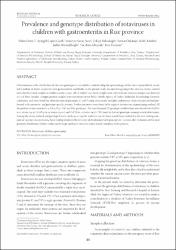Prevalence and genotype distribution of rotaviruses in children with gastroenteritis in Rize province

Göster/
Erişim
info:eu-repo/semantics/openAccessTarih
2015Yazar
Dereci, SelimÇiçek, Ayşegül Çopur
Acar, Sümeyra Savaş
Bakkaloğlu, Zekiye
Özkasap, Serdar
Kanber, Kadri
Hacısalihoğlu, Şadan
Albayrak, Yücehan
Durmaz, Rıza
Üst veri
Tüm öğe kaydını gösterKünye
ereci, S., Çopur Çiçek, A., Savaş Acar, S., Bakkaloğlu, Z., Özkasap, S., Kanber, K., Hacisalihoğlu, Şadan, Albayrak, Y., & Durmaz, R. (2015). Prevalence and genotype distribution of rotaviruses in children with gastroenteritis in Rize province. Bosnian Journal of Basic Medical Sciences, 15(3), 35–39. https://doi.org/10.17305/bjbms.2015.469Özet
Determination of the distribution of rotavirus genotypes is essential for understanding the epidemiology of this virus responsible for nearly half a million of deaths in patients with gastroenteritis worldwide. in the present study, we aimed to genotype the rotavirus strains isolated from diarrheal stool samples in children under 5 years old. A total of 1297 fecal samples were collected, and rotavirus antigen was detected in 73 of these samples. Antigen-positive samples were transferred to the Public Health Agency of Turkey, Molecular Microbiology Research Laboratory, and were tested for determination of genotypes G and P using semi-nested multiplex polymerase chain reaction method performed with consensus- and genotype-specific primers. Twelve specimens were found to be negative for rotavirus in genotyping method. All the positive-strains were in G1-4, G8-9, P(4), P(8), and P(9) genotypes. the most frequent GP genotype combinations were found to be G9P(8) in 21 strains (34.4%), G2P(4) in 14 strains (23.0%), and G1P(8) in 12 strains (19.7%). We found 10 distinct genotypes amongst a total of 61 strains. Among the strains isolated and genotyped in our study, 90.2% (55/61) and 67.2% (41/61) have already been included in the two existing commercial vaccines. in conclusion, these findings implicate the necessity of development of region-specific vaccines after evaluation of the local genotype distribution. Further studies on the large number of rotavirus strains would contribute to this process.

















